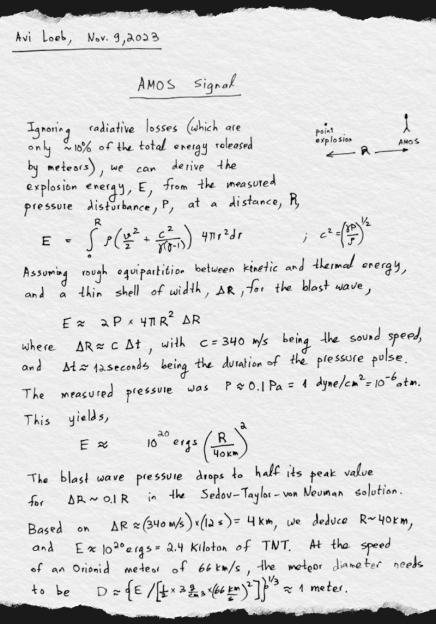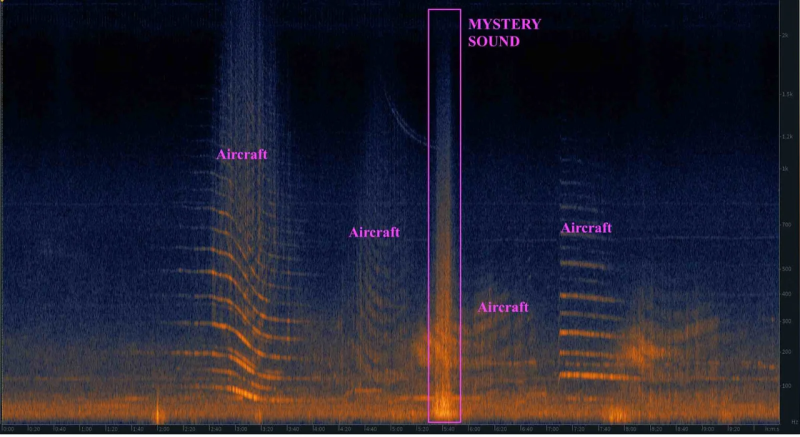Last month, thousands of people in New Hampshire took to social media to report an explosion in the sky that was strong enough to rattle windows. Naturally aliens were blamed by some, while cooler heads theorized it may have been a sonic boom from a military aircraft. But without any evidence, who could say?
Luckily for concerned residents, this was precisely the sort of event Harvard’s Galileo Project was designed to investigate. Officially described as a way to search for “technological signatures of Extraterrestrial Technological Civilizations (ETCs)”, the project keeps a constant watch on the sky with a collection of cameras and microphones. With their gear, the team was able to back up the anecdotal reports with with hard data.
As explained in a recent article on The Debrief written by project head [Avi Loeb], none of Galileo’s optical equipment captured anything interesting at the time. But it’s acoustic monitoring, omni-directional system (AMOS), which records from the infrasonic all the way to ultrasonic (specifically, 0.05 hertz to 190 kilohertz), got an earful during the 12-second event.
 [Avi] was able to take the data collected by AMOS and run it through the Taylor–von Neumann–Sedov solution, which was originally developed during World War II to estimate how much energy was released during the detonation of a nuclear bomb from the spherical blast-wave it produced.
[Avi] was able to take the data collected by AMOS and run it through the Taylor–von Neumann–Sedov solution, which was originally developed during World War II to estimate how much energy was released during the detonation of a nuclear bomb from the spherical blast-wave it produced.
By plugging the amplitude and duration of the pressure wave into the equation, he calculated an energy release of approximately 2.4 kilotons of TNT at a distance of about 40 kilometers (25 miles).
Since the detonation of a tactical nuclear weapon within a 40 km radius of Mount Washington would likely have been noticed by somebody, the likely culprit would therefore be some object entering the Earth’s atmosphere.
As it turns out, the Orionid meteor shower was just about at its peak in the skies over Massachusetts at that point. Given the average velocity of these particular meteors (66 km/s), [Avi] figures the source of the sound was a space rock of about a meter in diameter meeting its fiery end.
We know, aliens would have been more fun. But this is precisely the sort of grounded research that needs to happen for Unidentified Anomalous/Aerial Phenomena (UAP) to be taken seriously. We hadn’t heard of the Galileo Project before this, but will certainly be keeping an eye on its findings going forward.
Thanks to [PWalsh] for the tip.















Absolutely wild! I freaking love science!
Sweet! Good to see Loeb hasn’t completely lost it.
Student did the work & Loeb took credit.
Why does all the interesting stuff start happening in New Hampshire after I move 2500 miles away? Nothing like this ever happened in the 5 decades I spent living there…
Dang, 2.4 kilotons over MA? Gotta be a bit close for comfort
Look closely for a twang rising in pitch like a cartoon gun firing sound effect in the trail of the event.
Elmer Fudd taking pot shots at earth!
Nope.
Illudium Q-36 Explosive Space Modulator, but the fuze had been extinguished somehow…
You mean there was no earth-shattering kaboom?
Loeb, while a crackpot is very accomplished in his field and still capable of doing science. What surprises me is people talking about “x number of kilotons of TNT” as if it were a[n] SI unit. Normally people here would be freaking out.
Kilotons is a unit of explosive power equivalent to 1,000 tons of TNT, nothing SI about it.
But otherwise it should just read “x number of kilotons” the TNT is redundant.
The SI uni would be Gg TNT (Gigagrams of TNT)
It’s really unsatisfactory that the base unit of mass in the SI system has a prefix. Perhaps it should be renamed to avoid this. I think that either the Galileo or Einstein would be appropriate.
The proper SI unit would be Joules instead of mass, since we’re talking about energy.
I mean, if it existed, the SI unit would be whatever it was defined to be. But the general principle is that SI units are defined in terms of the seven base units (meters, kilograms, seconds etc.), along with a handful of physical constants like the speed of light and Planck’s constant, so an SI unit wouldn’t involve Gg. Note that “metric” units aren’t the same as SI – for instance, SI measures area and volume as m ² and m ³, not hectares or liters.
To define an SI replacement for kilotons, you’d have to incorporate (very) specific terms of reference regarding the preparation of the TNT, the conditions for exploding it and so on; but it’s hard to say exactly what dimensions it would have because kilotons aren’t a real unit anyway. They kind of measure energy (which SI measures in joules), but only alongside a bunch of loose assumptions about the profiles of power, pressure and other quantities over time. There really isn’t a single parameter that fully compares any two explosions.
Coincidentally, it’s very close to 10 Terajoules of energy.
The point of adhering to “pure SI” is that you should express everything in the most basic unit. Cubic meters for liters, pascals for bars, kelvins for degrees Celsius, seconds for hours and days… etc. As such, it’s perfectly useless since you always get numbers that are ridiculously large or stupidly small, or practically meaningless. Meet you at the cafe in 4000 seconds. Got it? Damn, it’s 315 K outside today – am I boiling or am I freezing?
That’s why the “metric system” has all these convenience units like kilowatt-Hours, or kiloton-equivalent of TNT, to make the numbers relatable in some way. It’s in principle no different than having yards, feet and inches because you’re more comfortable using those magnitudes by tradition.
https://xkcd.com/2707/
So, how many Olympic sized swimming pools will 10 Terajoules evaporate?
Loeb is not in the least bit a crackpot, and as scientists we need to be more precise in our language.
The best (worst, actually) you can say about Loeb is that he is fringe. He has all the training and expertise of a scientist, but takes views that are not politically correct in the field.
His blog is highly interesting, for those people who have an open mind, because he simply poses the hypotheses and then goes to look for evidence. He’s recovered matter from an interstellar object (interstellar meteor that hit Earth) and the evidence *suggests* that it might have been a constructed object; ie – a probe from another civilization.
https://avi-loeb.medium.com/the-im1-spherules-from-the-pacific-ocean-have-extrasolar-composition-f025cb03dec6
This has, of course, invited a ton of speculation and alternate explanations, which is how good science actually gets done.
>not politically correct in the field
Such as?
>which is how good science actually gets done.
It’s certainly one way, but it’s debatable whether it’s good science to first assume the most implausible scenario and then expect others to refute it. One hallmark of a crank is jumping to conclusions from the scantest aberration in data.
Example:
“A random detection rate of once per decade for meter-size interstellar objects implies that a few million such objects reside within the orbit of the Earth around the Sun at any given time.”
Yes, but you have two. It’s not nearly enough statistical evidence to say that it is a “once per decade” find instead of just getting lucky by the same coincidence/cause. Maybe you’ll spend the next hundred or thousand years looking for supporting evidence of the same kind.
Where bad scientists trip most often is with weak statistics and extrapolating from very little of it:
https://xkcd.com/605/
Lolz.
Pretty sure if I dropped a magnet into the ocean and declared what I pulled up could be the remains of a UFO, you’d declare me a crackpot and not a scientist.
At least Loeb’s crackpottery is reasonably harmless, it not like he’s claiming mega doses of vitamin C will cure cancer or something.
What’s all this noise in the low freq ? Hum ?
Where I live we got very strong 100Hz (20 dB above noise) and sometimes some strong harmonics (200,300,400)
It’s either The Hum (https://thehum.info/) or something you can track down and possibly mitigate.
Some decades ago there was a similar bang overhead here (in East Central Scotland). At the time there was an active airbase not far away and a lot of people, including me, rang up to ask if one of their aircraft had broken the sound barrier overhead. They denied it, and it seemed unlikely to be the Russians, but this could be a plausible explanation of what we heard.
“This just in to the Channel 11 Newsroom… Nuclear warhead detonates over New England. Details on 6:00 news.”
“Update: it was a small, tactical nuclear device. Nothing to worry about.”
The kilogram/gram controversy seems to be left over from the old ‘cgs’ system of units, in which it makes a certain amount of sense. cgs meant “centimeter gram second,” which gives you energy in ergs and force in dynes. I once took an engineering correspondence course in which the physics test did everything in cgs. There was also a circuits book that used abvolts and abamperes. It really didn’t matter much, and it has been handy for crossword puzzles.